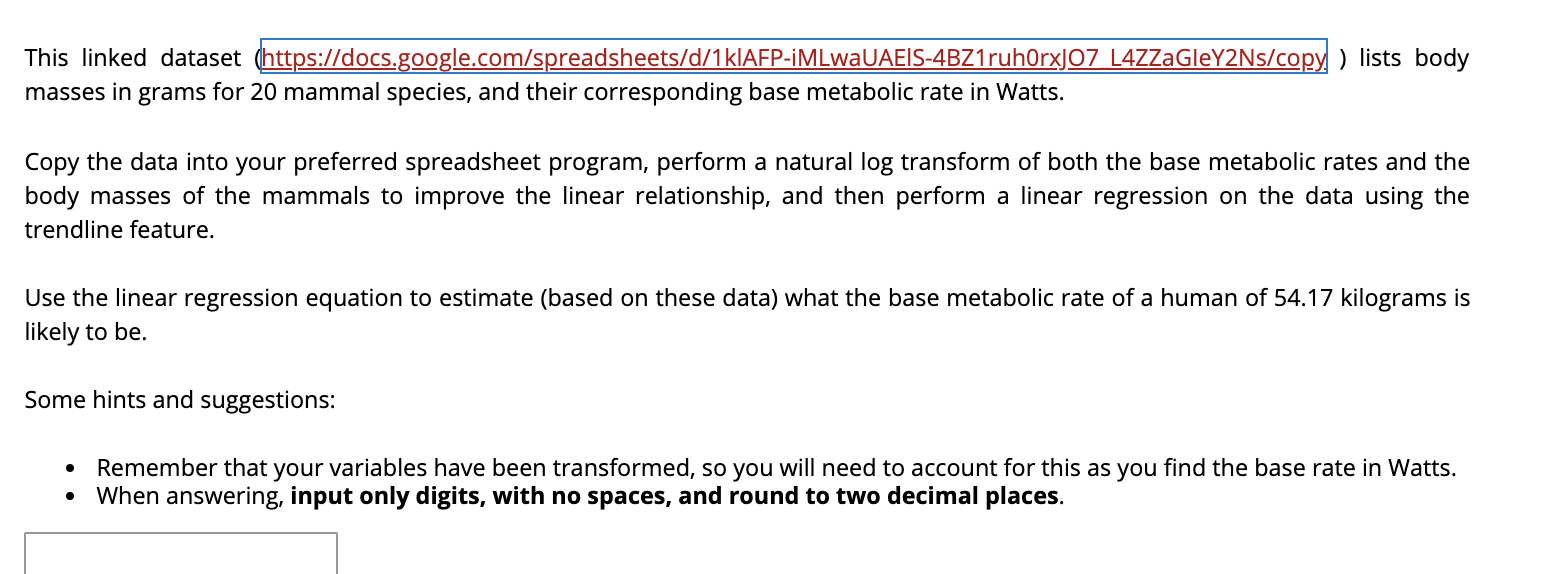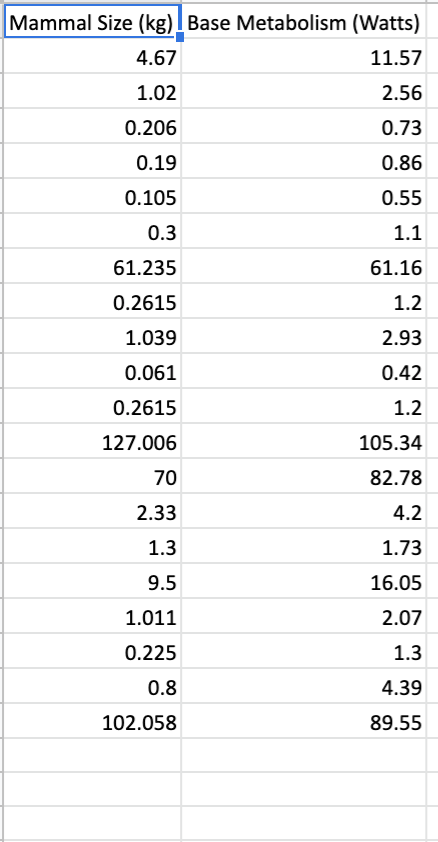This linked dataset (https://docs.google.com/spreadsheets/d/1kIAFP-iMLwaUAEIS-4BZ1ruh0rxJ07 L4ZZaGleY2Ns/copy ) lists body masses in grams for 20 mammal species, and their corresponding base metabolic rate in Watts. Copy the data into your preferred spreadsheet program, perform a natural log transform of both the base metabolic rates and the body masses of the mammals to improve the linear relationship, and then perform a linear regression on the data using the trendline feature. Use the linear regression equation to estimate (based on these data) what the base metabolic rate of a human of 54.17 kilograms is likely to be. Some hints and suggestions: Remember that your variables have been transformed, so you will need to account for this as you find the base rate in Watts. When answering, input only digits, with no spaces, and round to two decimal places. Mammal Size (kg) Base Metabolism (Watts) 4.67 11.57 1.02 2.56 0.206 0.73 0.19 0.86 0.105 0.55 0.3 1.1 61.235 61.16 0.2615 1.2 1.039 2.93 0.061 0.42 0.2615 1.2 127.006 105.34 70 82.78 2.33 4.2 1.3 1.73 9.5 16.05 1.011 2.07 0.225 1.3 0.8 4.39 102.058 89.55
This linked dataset (https://docs.google.com/spreadsheets/d/1kIAFP-iMLwaUAEIS-4BZ1ruh0rxJ07 L4ZZaGleY2Ns/copy ) lists body masses in grams for 20 mammal species, and their corresponding base metabolic rate in Watts. Copy the data into your preferred spreadsheet program, perform a natural log transform of both the base metabolic rates and the body masses of the mammals to improve the linear relationship, and then perform a linear regression on the data using the trendline feature. Use the linear regression equation to estimate (based on these data) what the base metabolic rate of a human of 54.17 kilograms is likely to be. Some hints and suggestions: Remember that your variables have been transformed, so you will need to account for this as you find the base rate in Watts. When answering, input only digits, with no spaces, and round to two decimal places. Mammal Size (kg) Base Metabolism (Watts) 4.67 11.57 1.02 2.56 0.206 0.73 0.19 0.86 0.105 0.55 0.3 1.1 61.235 61.16 0.2615 1.2 1.039 2.93 0.061 0.42 0.2615 1.2 127.006 105.34 70 82.78 2.33 4.2 1.3 1.73 9.5 16.05 1.011 2.07 0.225 1.3 0.8 4.39 102.058 89.55
Chemical Principles in the Laboratory
11th Edition
ISBN:9781305264434
Author:Emil Slowinski, Wayne C. Wolsey, Robert Rossi
Publisher:Emil Slowinski, Wayne C. Wolsey, Robert Rossi
Chapter21: Rates Of Chemical Reactions, Ii. A Clock Reaction
Section: Chapter Questions
Problem 2ASA
Related questions
Question
please highlight the correct answer

Transcribed Image Text:This linked dataset (https://docs.google.com/spreadsheets/d/1kIAFP-iMLwaUAEIS-4BZ1ruh0rxJ07 L4ZZaGleY2Ns/copy ) lists body
masses in grams for 20 mammal species, and their corresponding base metabolic rate in Watts.
Copy the data into your preferred spreadsheet program, perform a natural log transform of both the base metabolic rates and the
body masses of the mammals to improve the linear relationship, and then perform a linear regression on the data using the
trendline feature.
Use the linear regression equation to estimate (based on these data) what the base metabolic rate of a human of 54.17 kilograms is
likely to be.
Some hints and suggestions:
Remember that your variables have been transformed, so you will need to account for this as you find the base rate in Watts.
When answering, input only digits, with no spaces, and round to two decimal places.

Transcribed Image Text:Mammal Size (kg) Base Metabolism (Watts)
4.67
11.57
1.02
2.56
0.206
0.73
0.19
0.86
0.105
0.55
0.3
1.1
61.235
61.16
0.2615
1.2
1.039
2.93
0.061
0.42
0.2615
1.2
127.006
105.34
70
82.78
2.33
4.2
1.3
1.73
9.5
16.05
1.011
2.07
0.225
1.3
0.8
4.39
102.058
89.55
Expert Solution
This question has been solved!
Explore an expertly crafted, step-by-step solution for a thorough understanding of key concepts.
This is a popular solution!
Trending now
This is a popular solution!
Step by step
Solved in 4 steps with 3 images

Knowledge Booster
Learn more about
Need a deep-dive on the concept behind this application? Look no further. Learn more about this topic, chemistry and related others by exploring similar questions and additional content below.Recommended textbooks for you

Chemical Principles in the Laboratory
Chemistry
ISBN:
9781305264434
Author:
Emil Slowinski, Wayne C. Wolsey, Robert Rossi
Publisher:
Brooks Cole

Chemical Principles in the Laboratory
Chemistry
ISBN:
9781305264434
Author:
Emil Slowinski, Wayne C. Wolsey, Robert Rossi
Publisher:
Brooks Cole